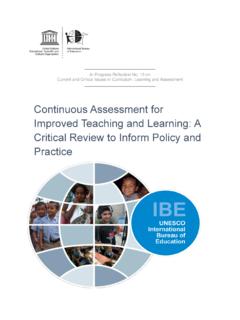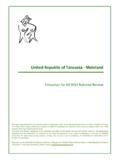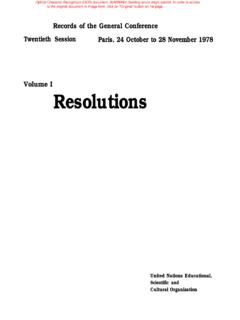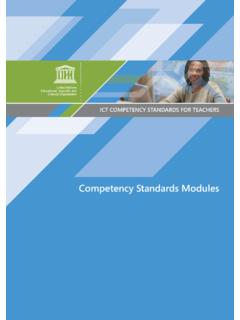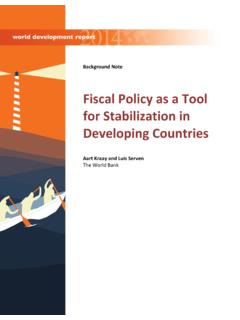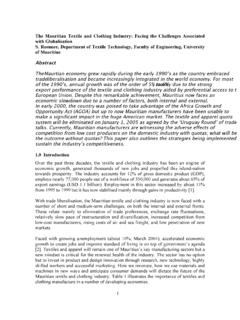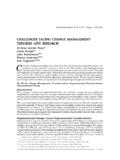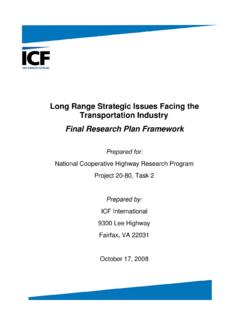Transcription of Skills development for youth living with disabilities …
1 2012/ED/EFA/MRT/PI/28 Background paper prepared for the Education for All Global Monitoring Report 2012 youth and Skills : Putting education to work Skills development for youth living with disabilities in four developing countries Maria Kett 2012 This paper was commissioned by the Education for All Global Monitoring Report as background information to assist in drafting the 2012 report. It has not been edited by the team. The views and opinions expressed in this paper are those of the author(s) and should not be attributed to the EFA Global Monitoring Report or to UNESCO. The papers can be cited with the following reference: Paper commissioned for the EFA Global Monitoring Report 2012, youth and Skills : Putting education to work For further information, please contact Revised Draft August 2012 1 Education for All Global Monitoring Report 2012 Background Paper Skills development for youth living with disabilities in four developing countries Author: Maria Kett Assistant Director Leonard Cheshire Disability and Inclusive development Centre University College London August 2012 Revised Draft August 2012 2 Table of Contents Acronyms.
2 3 Abstract .. 4 1. Introduction .. 4 2. Analysis of different types of disabilities and their implication for access to education, training and employment in different country contexts .. 5 3. Skills development programmes for youth living with disabilities .. 7 Kenya .. 7 Sierra Leone .. 10 China .. 15 Sri 18 4. Conclusions .. 21 5. Policy Recommendations .. 23 References .. 24 Revised Draft August 2012 3 Acronyms CDPF China Disabled Persons Federation COOPI - Cooperazione Internazionale CRPD - United Nations Convention on the Rights of Persons with disabilities DPO Disabled Persons Organisation EADSNE European Agency for development in Special Needs Education GoK Government of Kenya GoSL Government of Sri Lanka ICT Information and communication technology IDP Internally displaced persons ILO International Labour Organisation KESSP Kenya Education Sector Support Programme 2005-2010 () KNSPWD - Kenya National Survey on Persons with disabilities LCD Leonard Cheshire Disability MoHEST Kenyan Ministry of Higher Education Science and Technology MoYAS Kenyan Ministry of youth Affairs and Sports NGO Non-Governmental Organisation SIYB - Start and Improve Your Business SLUDI Sierra Leone Union of Disabled Individuals TEVC Technical and Vocational Education Commission UNDESA - United Nations Department of Economic and Social Affairs UNESCAP - United Nations Economic and Social Commission for Asia and the Pacific VTA Vocational Training Authority VTC Vocational Training Centre WPAY World Programme of Action for youth YEI World Bank youth Employment Inventory YMCA Young Man s Christian Association Revised Draft August 2012 4 Abstract This paper outlines some of the key challenges and opportunities regarding Skills development for youth with disabilities .
3 It focuses on those who are no longer in formal education, but who, for a variety of reasons, are not yet in formal employment. Where possible, it outlines the extent of labour force participation amongst youth living with disabilities , and discusses the barriers to participation. In order to highlight these challenges and opportunities, the paper explores the situation in four low- and middle-income countries to better understand how economic growth, or lack thereof, impacts on youth employment. The four countries selected China, Sri Lanka, Kenya and Sierra Leone all experience high youth unemployment rates (in line with many countries across the world) but for a variety of different reasons. All four countries have also made attempts to redress the inequities experienced by persons with disabilities , but as yet it is unclear the extent to which youth with disabilities have been impacted by these initiatives.
4 This report examines what opportunities are available to youth with disabilities specifically, and how effective are they in facilitating social inclusion and creating sustainable employment. Using case studies to illustrate successful targeted programmes, the paper also draws together information on key policies and practices that appear to be significant components in facilitating social inclusion and creating sustainable employment opportunities. 1. Introduction It is estimated that there are between 180 and 220 million youth with disabilities worldwide, of which nearly 80 per cent live in developing countries (UNDESA 2012: 6). They face the same range of issues and challenges as all young people, including lack of access to education, employment, healthcare and social services. But, as a small but growing literature on employment among youth with disabilities finds, they are affected in far more complex ways.
5 In employment markets, youth are often the last in and the first out, but for youth with disabilities , even the possibility of being last in is often not a reality. Lack of inclusion in education and Skills development initiatives for young people with disabilities foreshadows a lifetime of unemployment and marginal employment among a population eager to work. To the lack of access to education, health care and social services are added discriminatory beliefs and attitudes, inaccessible environments, and physical and communication barriers that contribute to further marginalisation and exclusion from social and economic life (UNDESA 2012: 6). This may be further compounded by a range of other factors, including gender, with disabled girls being additionally disadvantaged, even compared to disabled boys. One of the most important advances for persons with disabilities in the last decade has been the UN Convention on the Rights of Persons with disabilities (CRPD).
6 Though it has no mention of youth as a specific category, young people with disabilities played a significant role in the drafting of the Convention and their needs and interests many around issues of skill development and employment are reflected throughout the Convention. But how is this being translated into practice? Revised Draft August 2012 5 The issues of Skills and employment addressed in the CPRD are similar to those raised in the World Programme of Action for youth (WPAY),1 reflecting the similarities of the challenges faced by youth with disabilities and those of their non-disabled peers (UNDESA 2012: 14). These common areas of concern include employment issues, ranging from the creation of self-employment opportunities through to programmes to promote youth employment; voluntary programmes and technical training. These are also the areas highlighted in a recent UN youth with disabilities report and include the positive role information and communication technology (ICT) is playing in the lives of many, for example the use of mobile phones and computers which can facilitate communication, participation and access, particularly in education and employment (UNDESA 2012).
7 2. Analysis of different types of disabilities and their implication for access to education, training and employment in different country contexts There is strikingly little information available on the employment of youth with disabilities ; in some cases, broad information on employment rates for disabled young people may be available through national censuses or large scale surveys, but this information is rarely disaggregated by gender, type of disability or geographic location. This makes comparison within and between countries complicated, as there is not enough evidence to substantiate theories or design meaningful interventions. Even less well documented are school completion rates and level of qualifications attained for youth with disabilities . This makes it difficult to establish a causal link between young people with disabilities and their achievements (or lack thereof) at school, in Skills training or in their transition into the workplace.
8 The European Agency for development in Special Needs Education (EADSNE) published a report which examined the transition from school to employment in 16 European countries , including an overview of which strategies and processes were most effective, as well as an analysis of barriers and significant factors in the transition process (EADSNE 2002). These included the mismatch between vocational training and the labour market an area that still has significant gaps globally. The report also highlighted issues of policy implementation; the involvement of students (and their families); guidance, the use of Individual Plans (IEP); and cooperation and collaboration between stakeholders. The report also discussed the variety of models used to facilitate transition from school to employment (including work placements, work experience, training schemes and accreditation); the support available; networks; as well as policy measures.
9 Finally, it listed a number of recommendations aimed at each of these areas and for different points of intervention from policy makers to practitioners (EADSNE 2002). The International Labour Organisation (ILO) has made a concerted effort to identify issues and challenges facing persons with disabilities in attaining decent work. They have produced a number of reports and guidelines on promotion, training and employment opportunities for persons with disabilities , including those with intellectual disabilities , although few are specifically focused on youth ( Brewer 2004; Freedman 2008; Buckup 2010; Parmenter 2011). As Freedman (2008) notes, while it is difficult to gain an accurate idea of the number of youth with disabilities in 1 Revised Draft August 2012 6 training or employment, all evidence available clearly indicates lower rates of labour force participation and higher rates of unemployment.
10 This disparity occurs even when legislation protects against discrimination in employment, and the situation may be worse in countries where limited employment rights or anti-discrimination policies for persons with disabilities are compounded by a lack of basic education, vocational Skills training or higher education opportunities (Freedman 2008: 17). This may particularly be the case in lower and middle income countries . Some efforts have been made to redress these inequities, particularly in higher-income countries . These range from specific education interventions, facilitated access such as support workers, ICT and other adaptations to the workplace, through to targeted training and employment There is not space in this paper to list the array of programmes available for young people with disabilities , but the World Bank youth Employment Inventory (YEI) has attempted to compile an inventory of interventions designed to integrate young people into the labour An analysis of programmes included in the inventory concluded that interventions oriented towards disadvantaged youth are as good, if not better, than programmes with no particular orientation (Betcherman et al 2007) so presumably this would also be the same for programmes aimed at youth with disabilities .



